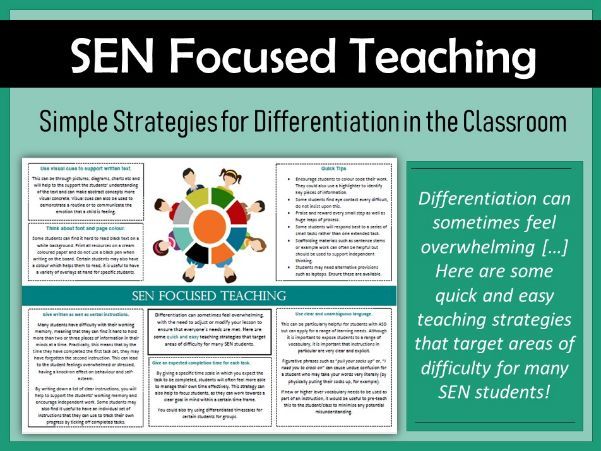490Uploads
373k+Views
253k+Downloads
Special educational needs

Teaching Strategies for ADHD
A well presented and useful A3 document that lists a number of teaching strategies for students with ADHD. Strategies are given to specifically target and support each area of difficulty.

Teaching Strategies for Students with Dyslexia
A well presented and useful A3 document that lists a number of teaching strategies for students with dyslexia. Strategies are given to specifically target and support each area of difficulty. These are:
Reading
Spelling
Handwriting
Copying
Processing
Maths
Focus
Time management

Teaching Strategies for Autism (ASD)
A well presented and useful A3 document that lists a number of teaching strategies for students with autism. Strategies are given to specifically target and support each area of difficulty. These are:
Communication
Fine Motor Skills
Processing
Social Skills
Coping with Change
Unstructured Times
Sensory Difficulties

SEN Teaching Advice
The 0-25 SEND Code of Practice (2015) identifies ‘four broad areas of special educational need and support’:
Communication and interaction;
Cognition and learning;
Social, emotional and mental health;
Sensory and/or physical needs.
This A3 document gives a brief explanation of each area of need, along with several points of teaching advice for those looking to support students with SEN. These strategies are by means an exhaustive list, but aim to provide teachers with some basic methods of support.

Feelings / Emotions Cards
A set of 32 feelings/ emotions cards. Perfect for use with SEN - reluctant speakers etc, along with social skills interventions.

SEN Focused Teaching
Differentiation can sometimes feel like an overwhelming task that can complicate teaching, lesson planning and simply make our lives far more difficult. This useful A4 document details several strategies to use within your lesson in order to meet target many areas of difficulty for SEN students.

40 Hobbies and Interests Cards
40 hobbies and interests cards.
Students can choose the cards that represent their own hobbies and interests. Fantastic for a social skills intervention.

Phonics Worksheets
A range of worksheets designed to help students to improve their knowledge of letter-sound relationships and patterns, along with their decoding abilities to improve reading accuracy.
This bundle includes:
Rhyming words - 8 worksheets
Identifying beginning sounds - 8 worksheets
Identifying end sounds - 8 worksheets
Building words - 13 worksheets
decoding three syllable words - 3 worksheets
A fantastic resource for SEN / Lower ability/ EAL students, along with those with difficulties associated with dyslexia. Perfect for in class differentiation, homework/ prep work tasks or interventions.
Check out my shop for loads more free and inexpensive KS3 & KS4, Literacy and whole school resources.
Phonics Display / Cards
Rhyme Bingo Game (Phonics)
[Synonyms Starter / Plenary Tasks - Vocabulary (http://https://www.tes.com/teaching-resource/synonyms-starter-plenary-tasks-vocabulary-12083511)
Bank of Literacy Starters (Two Bonus Social Skills Activities!)
Comprehension and Inference Worksheets (SEN/ Intervention)

Building Words - English - Spelling SEN Worksheet Pack
This pack contains 9 worksheets on word building in which students are asked to use the letters given to build the word shown by the image and 4 worksheets on long / short middle vowel sounds.
Perfect for spelling interventions / EAL / SEN

How to use a TA effectively in the classroom mat
An A4 document for staff reviewing how they can use a TA effectively within the classroom.

SEN Strategies Takeaway Menu
A handy document that can be used by teaching staff. This document provides a list of teaching strategies that could be used to differentiate for SEN.

Spelling and Phonics Cards
This pack contains 18 spelling cards (two per each page) that can be used as part of a spelling/ phonics intervention, starter, plenary or as part of a planned lesson. This pack contains the words that my students have consistently struggled to spell.
Each card contains three sections:
Make - Students have to make the word out of Play-Doe, sand, etc within the outline provided.
Look- The word is then used in a sentence with an image.
Write- Students write the word between the handwriting guide lines.
Write- Students write the word without the help of the guide lines.
These cards should be printed, cut out and then laminated in order for them to be re-used. All you will need is a dry-wipe pen and a tub of Play-Doh (or similar.) This activity works well as a more active alternative to the standard ‘look, cover, write’ method of teaching spellings.













